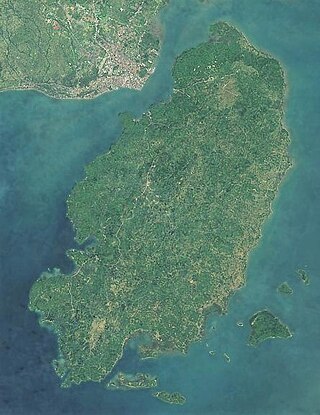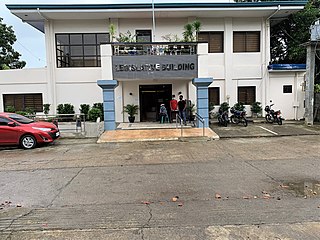
Guimaras, officially the Province of Guimaras, is an island province in the Philippines located in the Western Visayas region. The capital is Jordan, while the largest local government unit is the municipality of Buenavista. The province is situated in Panay Gulf, between the islands of Panay and Negros. To the northwest is the province of Iloilo and to the southeast is Negros Occidental. The whole island is part of the Metro Iloilo–Guimaras, one of the twelve metropolitan areas of the Philippines.

Buenavista, officially the Municipality of Buenavista, is a 2nd class municipality and the largest settlement in the province of Guimaras, Philippines. According to the 2020 census, it has a population of 52,899 people.

Jordan, officially the Municipality of Jordan, is a 3rd class municipality and capital of the province of Guimaras, Philippines. The name itself should not to be confused with the country of Jordan, which had its capital at Amman. According to the 2020 census, it has a population of 39,566 people, making it the third largest settlement in the province.

Leganes, officially the Municipality of Leganes, is a 4th class municipality in the province of Iloilo, Philippines. According to the 2020 census, it has a population of 34,725 people.

Libacao, officially the Municipality of Libacao, is a 3rd class municipality in the province of Aklan, Philippines. According to the 2020 census, it has a population of 28,272 people.

Pontevedra, officially the Municipality of Pontevedra, is a 3rd class municipality in the province of Negros Occidental, Philippines. According to the 2020 census, it has a population of 54,502 people.

Pulupandan, officially the Municipality of Pulupandan, is a 3rd class municipality in the province of Negros Occidental, Philippines. According to the 2020 census, it has a population of 30,117 people.

San Lorenzo, officially the Municipality of San Lorenzo, is a 5th class municipality in the province of Guimaras, Philippines. According to the 2020 census, it has a population of 29,444 people.

Nueva Valencia, officially the Municipality of Nueva Valencia, is a 3rd class municipality in the province of Guimaras, Philippines. According to the 2020 census, it has a population of 42,771 people.

Anilao, officially the Municipality of Anilao, is a 4th class municipality in the province of Iloilo, Philippines. According to the 2020 census, it has a population of 30,520 people.

Badiangan, officially the Municipality of Badiangan, is a 4th class municipality in the province of Iloilo, Philippines. According to the 2020 census, it has a population of 27,056 people.

Barotac Viejo, officially the Municipality of Barotac Viejo, is a 3rd class municipality in the province of Iloilo, Philippines. According to the 2020 census, it has a population of 48,614 people.

Batad, officially the Municipality of Batad, is a 5th class municipality in the province of Iloilo, Philippines. According to the 2020 census, it has a population of 22,157 people.

Lambunao, officially the Municipality of Lambunao, is a 1st class municipality in the province of Iloilo, Philippines. According to the 2020 census, it has a population of 81,236 people.

Lemery, officially the Municipality of Lemery, is a 4th class municipality in the province of Iloilo, Philippines. According to the 2020 census, it has a population of 31,414 people.

Leon, officially the Municipality of Leon, is a 2nd class municipality in the province of Iloilo, Philippines. According to the 2020 census, it has a population of 51,990 people.

Maasin, officially the Municipality of Maasin, is a 3rd class municipality in the province of Iloilo, Philippines. According to the 2020 census, it has a population of 38,461 people.

Oton, officially the Municipality of Oton, is a 1st class municipality in the province of Iloilo, Philippines. According to the 2020 census, it has a population of 98,509 people making it as the most populous town in the province and the entire Panay island.

San Dionisio, officially the Municipality of San Dionisio, is a 4th class municipality in the province of Iloilo, Philippines. According to the 2020 census, it has a population of 39,048 people.

San Miguel, officially the Municipality of San Miguel, is a 4th class municipality in the province of Iloilo, Philippines. According to the 2020 census, it has a population of 30,115 people.
























